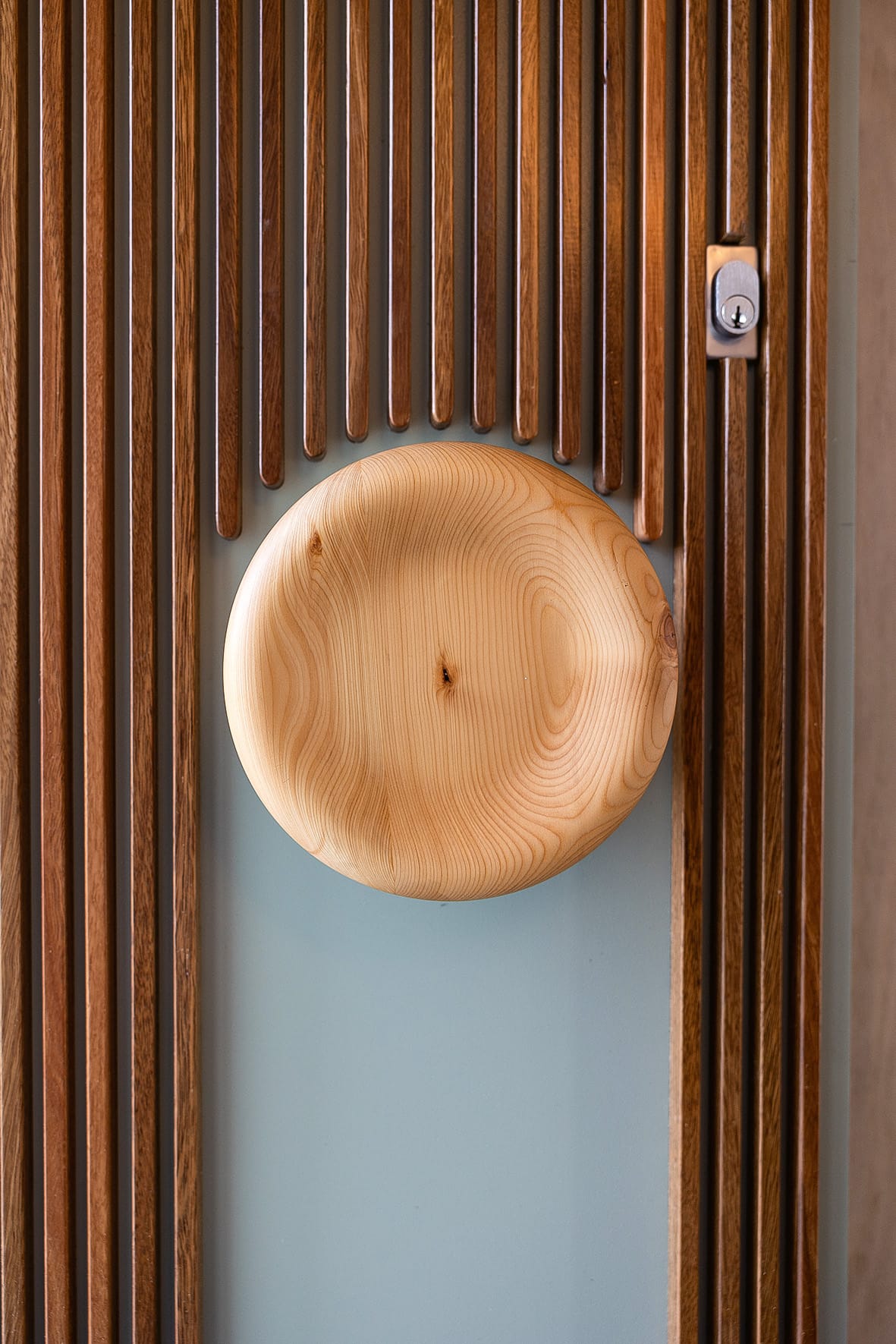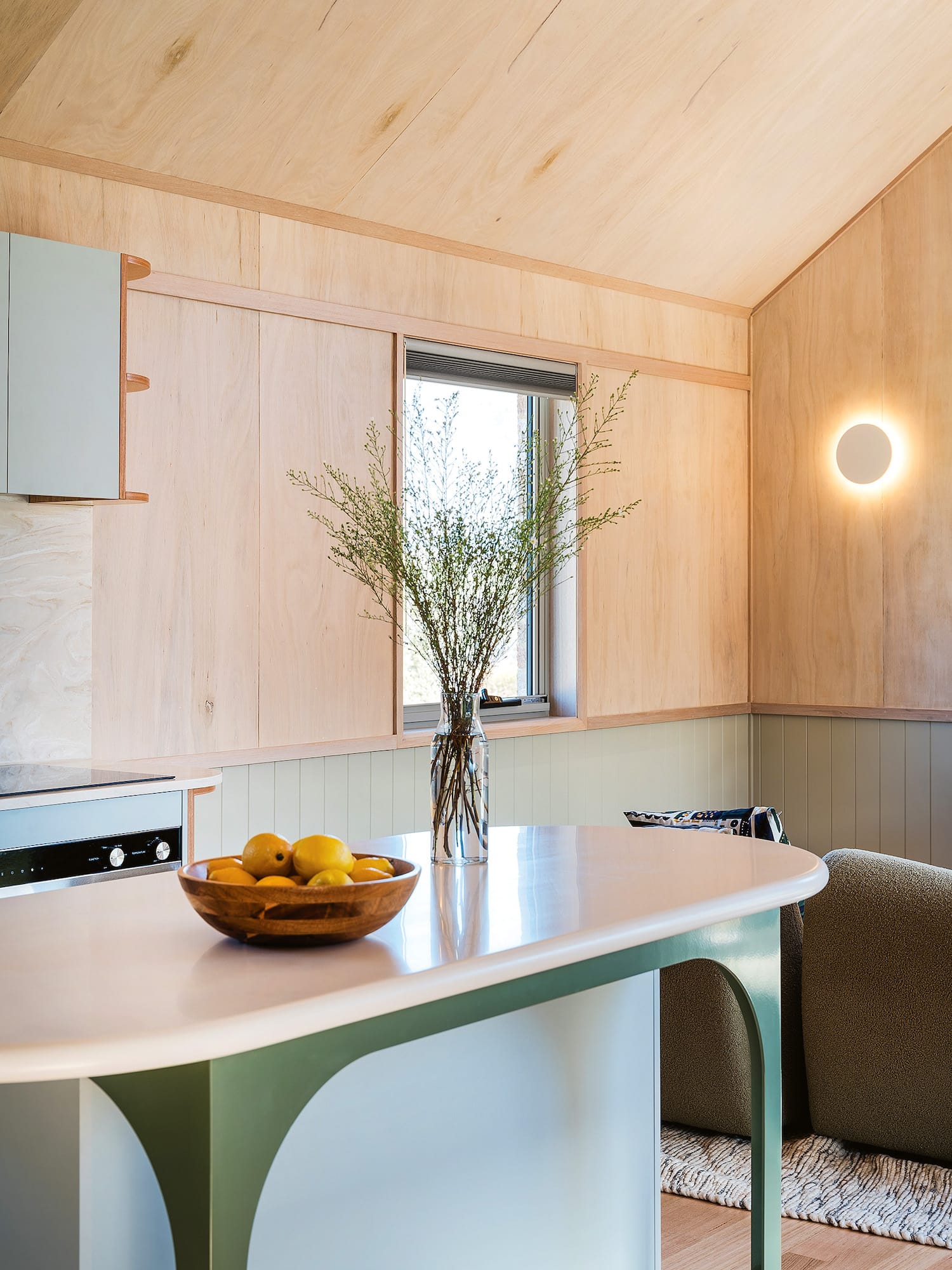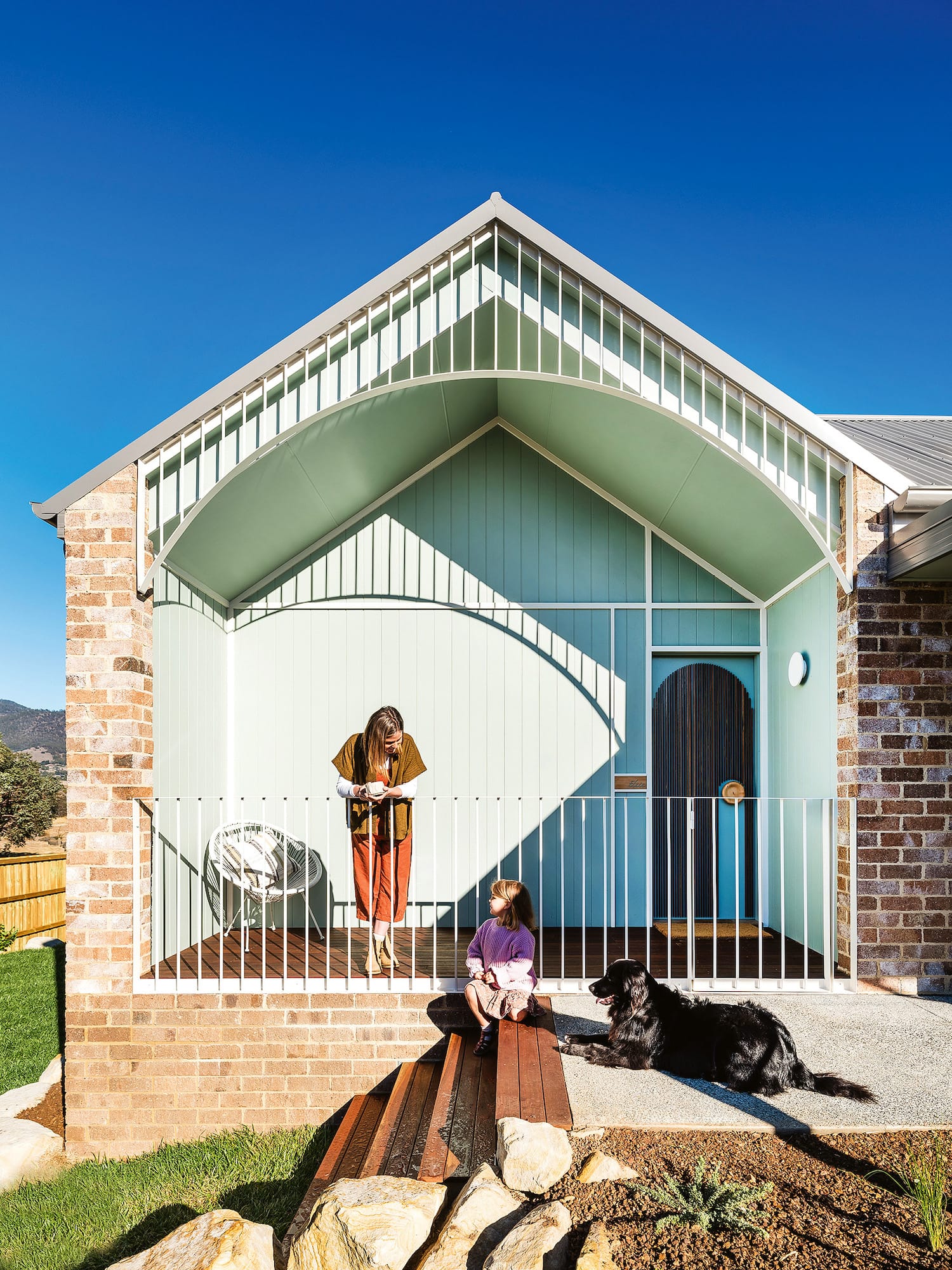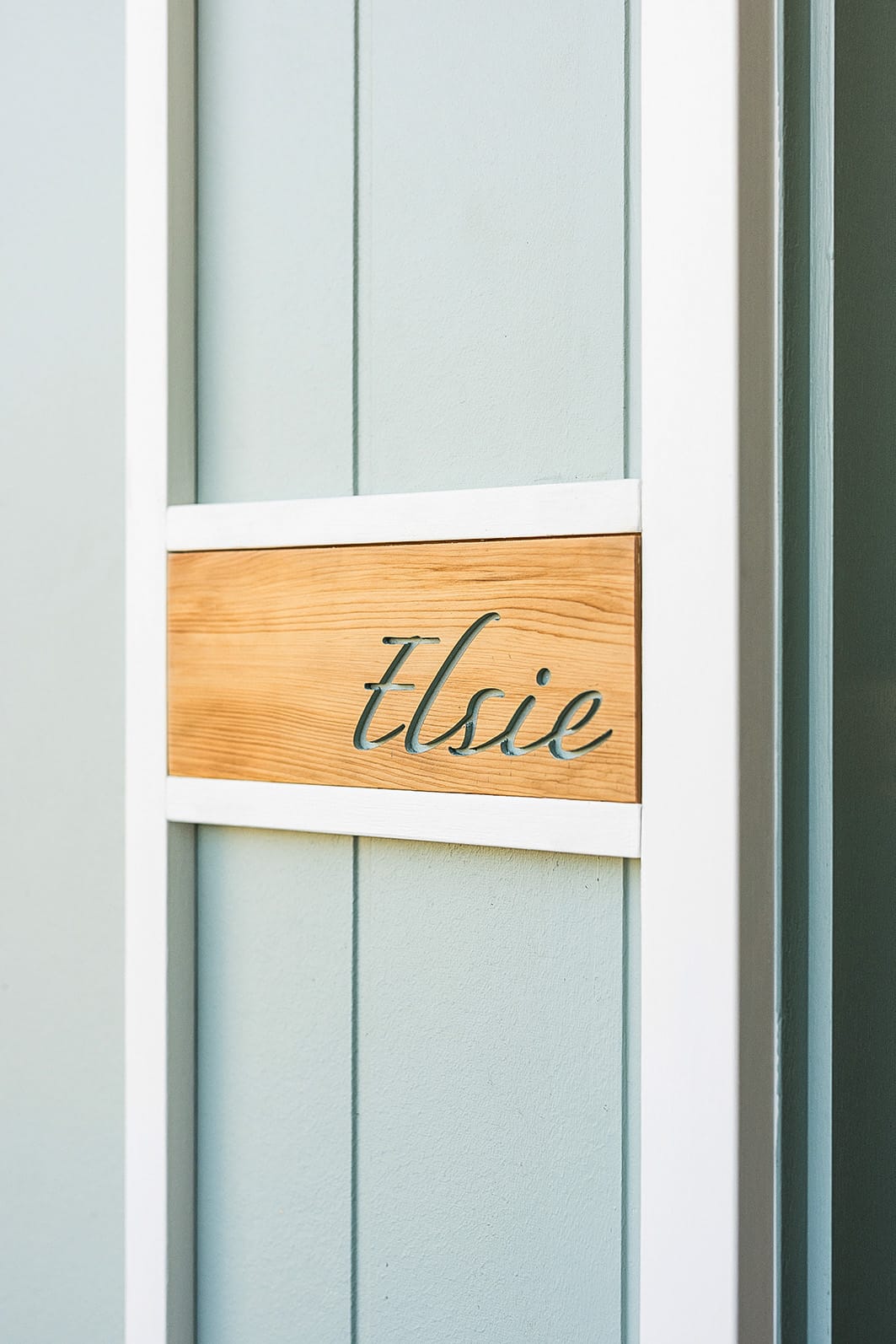
Two radical prototype homes designed for women and children escaping violence are setting new standards for social housing.
Words Cate Sumner
Photography Adam Gibson and Nina Hamilton
CAN a home help its occupants to heal? Can a door handle evoke emotion?
Janet Saunders thinks so. In late March, the CEO of the Hobart Women’s Shelter showed two women and their children around their new homes – two prototypes designed specifically for safety, privacy and connection.
“It was such a special moment to be with the women when they walked in,” Saunders recalls. “Their breath was taken away from the moment they put their hands on the round, handcrafted door handle. The women couldn’t believe that someone had taken the time to create this for them. They can see in those homes the love and the passion they have been made with.”
The homes – named Elsie and Isabel after their principal sponsors – represent radical thinking in the design and funding of social housing. They’ve been developed and built entirely with philanthropic funds, including donations from hundreds of people who contributed to the shelter’s buy-a-brick campaign. They showcase the skills and cutting-edge thinking of a raft of design and construction experts, many of whom donated their services and building materials. And, perhaps most radically, the homes are among the first in Australia designed with sustained input from women and children escaping violence or homelessness.


Handcrafted front-door handle in celery-top pine; curved design and subtle lighting. Photography Adam Gibson and Nina Hamilton.
“These homes were designed with women, not for women, and it makes a difference,” says Samantha Donnelly, an academic and author of a 2019 design guide for refuge accommodation for women and children. As Galah went to press, the two homes were among 30 projects shortlisted in the 2024 ArchitectureAU Award for Social Impact, an accolade that celebrates architectural work that “preferences empathy over aesthetics”.
The two-bedroom prototypes are intended to be homes for as long as it takes their residents to find permanent accommodation. Key design features include subtle lighting, a colour palette that connects the home’s interior and exterior with the landscape, and the use of local brick and timber.
Much of the design’s influence is emotional, conveying a sense of calm that Saunders says will give families “the space to heal and recover”. One of the residents loved the feeling of the curved pantry. “She talked about the curves all through the design, how you just feel them. They feel so round, so nurturing. And then you look outside, and you have the water. One of the women said that the home feels like a sanctuary. That tells us we succeeded in what we set out to do.”
This year, the Hobart Women’s Shelter marks 50 years of service, yet the need for new ways of thinking about women’s housing has never been more urgent. Since early 2020, more than 3300 women and children across Tasmania have been turned away from the shelter for lack of space. Modelling by Impact Economics shows Tasmanian women are being turned away from emergency accommodation at six times the national figure. This year, eight out of 10 women and children on the island are still being turned away from the shelter, a legacy of the pandemic.
After two summit meetings at Government House in Hobart in 2022 and 2023, the Hobart Women’s Shelter decided to rally partners and show how a different calibre of housing could be built. A grant from the Isabel Sims Endowment kicked off the project in 2022, enabling architects to begin a design process that put the occupants at the heart of every decision, through a series of conversations with women at the shelter.
Then the Elsie Cameron Foundation came on board as a significant funder, and the balance came from a statewide fundraising campaign run by the Hobart Women’s Shelter. Hundreds of people “bought a brick”, ranging from $20 individual donations to hundreds of dollars from book clubs and quilting groups, plus a $7500 donation by visiting US indie rock band Bon Iver via its 2 A Billion gender-equity campaign. More than $1.5 million was contributed to the project in direct donations or in-kind design services and building materials.
“There is a fundamental shift occurring where there is more interest in a mutual exchange that helps the greater social good,” says one of the participants, landscape architect and director of SBLA studio, Simone Bliss. “People want to contribute. Our studio values include equity and designing for people who don’t normally have the opportunity to be part of the conversation about how their built environment is created.” Says lighting consultant Landon Bannister of Southern Lighting & Distribution: “We were immediately aligned on the philosophy that everyone deserves quality.”
Building products and interior fixtures and fittings were donated by dozens of companies – some local, some global. Among them were five renewables companies that donated solar panels, batteries and installation. This will reduce living costs for residents.
The two Hobart-based architects leading the team – Emily Taylor of Core Collective Architects, and Chris Clinton of Christopher Clinton Architect – each donated hundreds of hours of time to develop the prototype. They’re proud that the project delivers high-quality, architect-designed, thermally efficient homes that can be built at scale, on time and at a competitive cost. “A lot of the elements in this design are not expensive, they just require thought and consideration,” says Taylor. “An example is the careful selection of colours and materials. We need to get better at investing in thought.”
Clinton regards the project as the most rewarding he’s ever worked on. “Every time you make a mark on a page or specify a building element, you have to remind yourself of who will be living in these homes, and what impact it will have on their lives.”


The design connects interior, exterior and the landscape; “Elsie” is named after one of the main sponsors, the Elsie Cameron Foundation. Photography Adam Gibson and Nina Hamilton.
As a final symbolic contribution, Clinton designed the front doors, sourcing the timber and crafting by hand the round front-door handles from celery-top pine, an endemic Tasmanian species. “The front door serves as the initial interaction with the home, requiring a sense of security, tactility and warmth,” he says. “Feeling the weight of the solid door combined with the softness of the celery top handle, imbued with craft and care, was important.”
Sonia van de Haar is a colour designer and founder of design practice Lymesmith. She worked with the design team to create a palette of colours and materials drawn from the surrounding environment, connecting the home with the mountain, river and trees. “The transition from being outside to being ‘at home’ is very important,” she says. “If home has been a place of fear, then it’s all the more important to create a new experience in these houses – one of transitioning to a place of safety, calm and beauty.”
Bliss adds that the fundamental intent was “to ensure the landscape held the women and children as a place to heal through materiality, colour and changing levels in the landscaping”. While the planting palette will change with time, as will the women and children who inhabit the homes, Bliss planted a waratah in each garden as a symbol of strength for women coming home. “This project is all about empathy. Everything about the design process, the conversations, stepping outside one’s own way of viewing the world. This is very different to other projects.”
The prototypes are the first of 25 homes the Hobart Women’s Shelter aims to build. Kingborough Council in southern Tasmania has gifted land to the shelter, and there are early discussions with a council in the north-west, where the need for social housing is acute. The shelter is keen to work with the state government agency Homes Tasmania, which is committed to building 10,000 homes in the next 10 years.
Saunders believes the prototypes set new standards for social housing for women and children in Tasmania and will create ripple effects across Australia. “If people don’t have a lot, there can sometimes be a mentality that they should be happy to take anything,” she says. “One of the impacts of these prototype homes is that we are potentially reshaping that thinking in the community. Everything works, it’s warm, there’s no mould, no condensation, no stains on the carpet.”
Already, the project’s impact can be counted. Five people have a safe, welcoming home. That’s 1825 bed nights a year in the first two homes; about 24,000 bed nights a year when all 25 homes are built.
Much of the impact, though, can’t be counted. One of the occupants, a young woman with two children, sent staff a note after her first night. “Just one last check-in from what feels like a different world! Sending deep gratitude to all who have helped me get here.”
Cate Sumner is a human rights lawyer who helped the Hobart Women’s Shelter team with grant funding and advocacy. Contribute to the Hobart Women’s Shelter’s ongoing Buy-a-Brick campaign at hobartws.org.au/buy-a-brick-campaign.